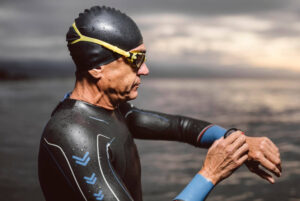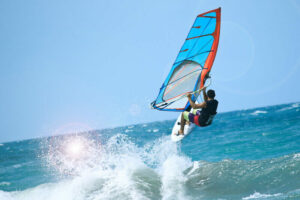Kitesurfing harnesses are an essential piece of equipment for any kitesurfer. While they serve as the vital link between the kite bar and your body, transferring the kite’s power, the harness for kitesurfing is frequently underestimated within the kiteboarding community.
They provide support, comfort, and control, allowing you to fully enjoy your kitesurfing experience. This guide will walk you through the different types of harnesses for kitesurfing, their features, and how to pick the right one for your needs.
In this article, you will get answers to the following questions:
- Are there different kite harnesses for women and men?
- What does the kite harness do?
- How to find the right kite harness size?
- What features do I need to take into account?
- Is a kite harness uncomfortable?
- Which kite harness is best for beginners?
The Kite Harness – A Short Introduction
A kite harness is an essential piece of equipment used in kitesurfing and other kite-related water sports. Its primary purpose is to provide support, comfort, and control for the kitesurfer. Here’s what a kite harness is for:
☞ Power Transfer: The harness is designed to transfer the pulling force generated by the kite from the kiter’s hands and arms to their core and lower body, particularly the waist or hips. This helps reduce fatigue and strain on the upper body.
☞ Control: A kite harness enables the kiter to maintain better control over the kite. By attaching to the harness, the kiter can use their body movements to steer and manipulate the kite, which is crucial for performing tricks, maneuvers, and controlling the kite’s power.
☞ Comfort: Kitesurfing sessions can be physically demanding and long. The harness provides added comfort by distributing the load across the kiter’s body, allowing them to ride for extended periods without excessive fatigue.
☞ Safety: Using a harness with a safety leash attachment is essential for safety. In case of an emergency or loss of control, the kiter can quickly release from the kite by activating the safety system, which is often connected to the harness.
Types of Kitesurfing Harnesses
There are several types of kitesurfing harnesses, each designed to cater to different preferences, riding styles, and levels of experience. The main three types of kitesurfing harnesses include:
Waist Harness
Waist harnesses are known for providing kitesurfers with a high degree of freedom of movement. They allow the rider to twist, turn, and rotate the upper body easily, which is essential for performing tricks and maneuvers.
These kite harnesses offer excellent lower back support, which is crucial for riders who engage in aggressive or freestyle kitesurfing. The support provided by a waist harness for kitesurfing helps distribute the load evenly across the back.
It typically features a spreader bar attachment point at the front, which connects to the kite’s control lines. The spreader bar can be fixed or sliding, depending on the rider’s preference.
Many waist kite harnesses come with padding in the lumbar and hip areas to enhance comfort during long kitesurfing sessions.
They are designed with multiple adjustment points, allowing riders to customize the fit to their body shape. This ensures a secure and comfortable fit.
Waist harnesses are commonly favored by experienced kitesurfers who prioritize maneuverability and control. They are often used for freestyle riding, wave riding, and more advanced kitesurfing styles.
Seat Harness
The defining feature of a seat harness is its emphasis on providing additional support to the lower body, particularly the hips and thighs. This design helps distribute the load evenly and reduces strain on the rider’s upper body.
Seat harnesses offer greater stability, making them a popular choice among beginners and those looking for added comfort and security. They are especially useful for long kitesurfing sessions.
Like waist kite harnesses, seat kite harnesses have a spreader bar attachment point at the front, which connects to the kite’s control lines. This attachment point can vary in style and design.
Seat harnesses are typically well-padded in the seat and hip areas to provide additional comfort, especially during extended rides.
They come with multiple adjustment points, allowing riders to customize the fit for their body shape. This ensures that the harness remains secure and comfortable.
Seat harnesses are suitable for a variety of kitesurfing styles and conditions. They are often chosen by riders who are looking for a balance between support and freedom of movement.
Chest Harness
A chest kite harness, also known as a “kite-specific harness” or “kiteboarding harness,” provides extra support to the upper body. It wraps around the chest and upper back, making it particularly suitable for disciplines that require more upper body control and movement, such as foiling or wave riding.
Chest harnesses are designed to minimize restrictions on the lower body, allowing riders to have more freedom of movement in the hips and thighs. This design is beneficial for specific kitesurfing styles where quick and agile movements are necessary.
These harnesses typically have attachment points at the chest or upper back for hooking into the kite’s control lines. The attachment setup may vary depending on the brand and model.
Some chest harnesses may come with additional attachment points for accessories like impact vests, leashes, or knives.
Chest kite harnesses are not as common as waist and seat harnesses but have gained popularity in recent years. It is often used in combination with a waist harness or a wetsuit waist harness.
Lately, Hybrid harnesses have become increasingly popular among kitesurfers looking for a balanced option that caters to various riding styles and comfort preferences.
Sizing and Fit
Choosing the right size and ensuring a proper fit for your kite harness is crucial for comfort, safety, and performance. Here’s a step-by-step guide on sizing and fitting a kite harness and a useful kitesurfing harness size chart.
Sizing a Kite Harness
Get your pens ready, because e are about to check off ten easy steps, that will lead you straight to your perfectly adjusted kite harness.
1. Measure Your Waist:
Use a soft tape measure to determine your waist size accurately. Measure at the narrowest part of your waist, which is typically just above the hips. Keep the tape measure snug but not tight to your body.
2. Check the Manufacturer’s Sizing Chart:
Different kite harness manufacturers may have slightly different sizing standards, so it’s essential to consult the specific brand’s sizing chart for the harness you’re interested in. Most brands will provide a size chart that correlates your waist measurement to the appropriate harness size.
3. Try It On:
Whenever possible, try on the harness before making a purchase. Ensure that it fits comfortably and snugly around your waist. It should be secure but not overly tight, allowing room for adjustments.
4. Adjustability:
Look for a harness that offers multiple adjustment points. These may include straps or buckles on the waistbelt, leg straps, and shoulder straps. A high degree of adjustability allows you to fine-tune the fit to your body shape.
5. Check for Comfort:
Make sure the harness feels comfortable. It should distribute the load evenly across your waist without any pressure points. Check the padding, especially in the lumbar and hip areas, to ensure it offers adequate cushioning.
6. Range of Motion:
Test the harness’s fit by moving your upper body as you would during kitesurfing. You should have a good range of motion without the harness shifting or riding up.
7. Leash Attachment:
Ensure the harness has a secure attachment point for your safety leash. The leash attachment should be easily accessible and reliable.
8. Test the Release Mechanism
If the harness has an emergency release or quick-release system, make sure you can easily operate it and that it functions correctly.
9. Consider Your Clothing:
Keep in mind what you will be wearing underneath the harness, such as a wetsuit or rash guard. The harness should accommodate your chosen attire without being too tight or too loose.
10. Seek Professional Assistance:
If you’re unsure about sizing and fit, consider seeking assistance from a knowledgeable salesperson or an instructor at your local kite shop. They can provide valuable guidance based on your body type and kitesurfing needs.
Remember that the right-sized and properly fitted kite harness is essential for your comfort and safety while kitesurfing. Taking the time to ensure a secure and comfortable fit will enhance your overall kitesurfing experience.
Kitesurfing Harness Size Chart
Kitesurfing harness size charts can vary slightly depending on the manufacturer and model of the harness. It’s essential to consult the specific sizing chart provided by the brand you’re interested in to ensure an accurate fit.
While kiteboards come in unisex models, harnesses for kitesurfing usually differentiate in their sizes between male and female bodies.
Kite Harness for Women
Size Waist (In/cm)
XS 23”-25” / 56-63
S 25”-27” / 63-70
M 27”-29” / 70-76
L 28”-32” / 76-82
Kite Harness for Men
Size Waist (In/cm)
XS 28”-30” / 71-78
S 30”-32” / 76-83
M 32”-34” / 81-88
L 34”-38” / 86-96
XL 38”-40” / 91-98
XXL 40+” / 95+
Please note that these are approximate waist size ranges and should be used as a starting point. Always check the specific manufacturer’s size chart to ensure a proper fit for the particular harness model you’re interested in.
Different brands may have slightly different sizing standards, so it’s essential to follow their recommendations for the most accurate sizing information.
Key Features
Kite harnesses come with various features to enhance comfort, safety, and performance during kitesurfing. Such as:
Spreader Bar: The spreader bar is the component that connects the kite’s control lines to the harness. It’s essential to choose a harness with a durable and reliable spreader bar. Some harnesses offer options for fixed or sliding spreader bars to cater to different riding styles.
Harness Hook: The harness hook is where the control lines attach to the harness. It should be strong, comfortable, and securely attached to the harness. Various options, including hook heights, materials, and styles, are available to suit different preferences.
Padding: Adequate padding in the lumbar and hip areas is essential for comfort during long kitesurfing sessions. Quality padding should provide cushioning without being too bulky.
Leash Attachment: A secure attachment point for your safety leash is a crucial safety feature. This attachment point should be easily accessible and reliable for quick releases when needed.
Materials: Look for a harness constructed from durable and quick-drying materials suitable for the marine environment. High-quality materials ensure the harness can withstand the rigors of kitesurfing.
D-Rings and Accessory Attachments: Additional attachment points, such as D-rings and loops, provide convenience for securing accessories like a knife, impact vest, or handle pass leash.
Adjustability: Multiple adjustment points on the harness allow you to customize the fit according to your body shape. This ensures a secure and comfortable fit.
Quick-Release Mechanism: Many harnesses are equipped with a quick-release mechanism, which allows you to detach from the kite in emergency situations. This feature enhances safety during kitesurfing.
Hybrid Features: Some harnesses offer hybrid features, combining elements of both waist and seat harnesses to provide a balance between freedom of movement and lower body support.
Women’s-Specific Design: Women’s harnesses are tailored to fit the female body comfortably and securely, with specific padding and adjustments to accommodate women’s shapes.
Ergonomic Design: A well-designed harness should distribute the load evenly across the rider’s body, preventing pressure points and discomfort during long sessions.
Color and Style: While not a functional feature, the color and style of a harness can be a personal preference, allowing you to express your individuality.
Maintenance and Care for Your Kite Harness
Kitesurfing is a sport, that can capture an athlete’s heart and mind in an instant – tempting them to lose sight of a very important part of the sport: the material. To extend the life of your kite harness:
☞ Rinse it with fresh water after each use to remove salt and sand.
☞ Dry it in the shade, away from direct sunlight.
☞ Check for wear and tear, and replace any damaged components.
☞ Store your harness in a cool, dry place, avoiding extreme temperatures.
Clearly, not only the board’s well-being is of importance, but your safety as well should always have priority. Here are a handful of useful safety aspects to considerate when using a kite harness:
☞ Use a safety leash to ensure you can quickly detach from the kite in emergency situations.
☞ Regularly inspect your harness for any signs of wear or damage.
☞ Ensure the harness fits snugly but is not overly tight, as this can restrict movement and circulation.
☞ Follow proper kitesurfing safety guidelines and take lessons if you’re a beginner.
Keeping this in mind, kitesurfing with the right kite harness for you can be the perfectly balanced mixture of control and fun, safety and adventure, and comfort and endurance.
Conclusion: Finding the Right Harness for Kitesurfing
The kite harness is more than just a piece of gear; it’s the connection between you and the exhilarating world of kitesurfing. As we’ve explored in this article, the right harness can make all the difference in your kitesurfing experience.
Whether you favor the freedom of movement offered by a waist harness, the added support of a seat harness, or the versatility of a hybrid, your choice should reflect your riding style and preferences. A well-fitted and high-quality harness will enhance your kitesurfing experience, providing support and control while keeping you safe on the water. So, remember to measure, adjust, and choose wisely, ensuring that your kite harness becomes a trusted companion on your kitesurfing journey.
FAQ – Most asked question about Kite harness
Yes, you can wear a wetsuit or other appropriate undergarments under your harness. Make sure your harness accommodates the additional layers comfortably.
Yes, women’s-specific harnesses are available, designed to provide a better fit and comfort for female riders. They take into account the anatomical differences of the female body.
Kitesurf harnesses are purpose-built for kitesurfing and may not be suitable for other water sports. It’s recommended to use harnesses designed specifically for the activity you’re engaged in to ensure safety and performance.
The lifespan of a kitesurf harness depends on factors like usage, care, and the quality of the harness. It’s essential to inspect your harness regularly for signs of wear and tear, and replace it when necessary to ensure safety and comfort.
Measure your waist accurately using a soft tape measure and consult the manufacturer’s kitesurfing harness size chart for the specific harness you’re interested in. Sizes are usually based on waist circumference.









